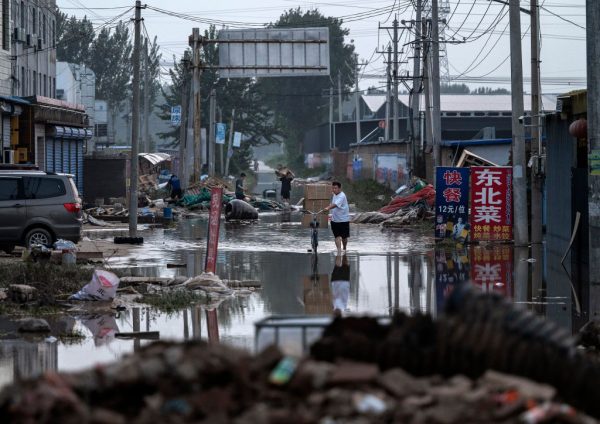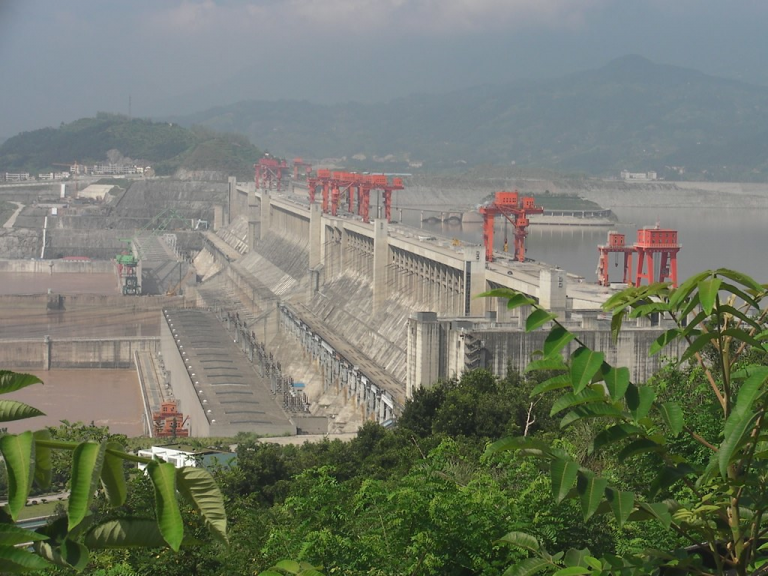Early this August, China was hit by devastating floods driven by typhoons. The country has a complex network of reservoirs that authorities manipulated to manage the resulting flood waters. This year, much like in the past, communist authorities intentionally flooded areas populated by millions of people in order to protect the nation’s capital, Beijing, and Xi Jinping’s prestige development the Xiong’an New Area, sacrificing an unknown amount of lives and property.
The Xiong’an New area is a massive development that was first established in April 2017, approximately 62 miles southwest of Beijing by Chinese leader Xi Jinping. Its intended purpose is to serve as a development hub for the Beijing-Tianjin-Hebei economic triangle, and is intended to replace many of the functions of Beijing, the capital.
Despite the CCP’s best efforts, Beijing was not spared from this year’s flooding. Tens of thousands of people were forced to evacuate and, according to communist authorities, dozens of people lost their lives. Even the Forbidden City, the seat of ancient China’s emperors kept dry for 600 years by its ingenious system of underground pipes, was not spared this year’s inundations.
One area in China that was severely impacted by the CCPs decision to discharge reservoirs was the city of Zhuozhou in Hebei Province. Unfortunately the city, home to some 628,000 people, is located between Beijing, on its upper reaches, and the Xiong’an New Area, on its lower reaches and was an area the CCP was willing to sacrifice to protect Beijing and Xiong’an.

Why were the floods so severe?
According to an official report published in 2020, China has more than 98,000 reservoirs of various types strewn across the country. Of these, more than 23,000 are large dams, making China the country with the most number of large dams.
Success
You are now signed up for our newsletter
Success
Check your email to complete sign up
China has nearly 100,000 reservoirs and the data shows that their capacity could theoretically meet all of China’s water consumption needs for a year. China should have enough water in its reservoirs for a year, even if it doesn’t rain, so it shouldn’t be afraid of drought or flood. But, in reality, the management of China’s reservoirs is chaotic, and the build quality of the reservoirs is questionable
In order to store flood water in reservoirs and take it out for use in times of drought, reservoirs need to be large enough to hold the yearly flow of the rivers that feed it. However, for various reasons, various parts of China have lowered the construction standards for reservoirs.
On paper, China’s 100,000 reservoirs can hold the required amounts of water, but in practice this is not the case. So officials have little choice other than to release flood waters lest a greater disaster occurs.
READ MORE:
- China Launches Retroactive Investigations Into Healthcare Sector Corruption
- Data Shows Massive Decline in US-China Trade
- Unprecedented Flooding in China Leads to Resentment, Protests
Politically motivated decision making
Beijing’s decision to flood communities is politically motivated decision making to keep the Beijing-Tianjin-Xiong’an New Area dry at the expense of cities/rural areas deemed less important by CCP authorities.
The summer of 2023 has made people realize that an even more frightening factor has come into play in the great flood, evidenced by the flooding of Zhuozhou.
Overseas Chinese-language media have obtained an internal document from the Chinese government, showing that Zhuozhou City had been designated as a flood relief area well in advance in order to protect Beijing and Xiong’an New Area.
The special document, issued on July 29, 2023, instructed that more than 20 reservoirs around Beijing would open their gates simultaneously, and the floodwaters would rush towards Zhuozhou. As it isn’t allowed to enter Baiyangdian, a group of natural water bodies, as normal, the flood water was directed towards Zhuozhou completely inundating the city.
The document specifically says that “the participants and staff members should strictly follow the confidential protocol of keeping the minutes secret, enforce the confidentiality responsibly, properly store the documents of the meeting, and vigorously prevent the leakage of confidential information.”
Authorities also said that it’s “strictly prohibited to bring mobile phones and other wireless mobile communication tools, as well as electronic devices for recording, video recording, photo-taking and information storage into the meeting venue.” This is to ensure only approved reporting on the floods was distributed.
READ MORE ON CHINA:
- Typhoon Khanun Makes Bizarre 90-degree Turn Towards Korea, Threatening Northeast China
- A Story of ‘Blind Love’ for Ancient China’s Valentine’s Day
- China Plans 1.5 Trillion in Financing to Prop Up Debt-Swamped Local Governments

Number of deaths unknown
The number of fatalities due to the discharge of flood waters is difficult to ascertain, as one cannot trust official reporting by the CCP, however commentary by some individuals on the ground provides some insight.
A civil rescue team obtained the testimony of a village leader in Matou village, Zhuozhou who said he discovered “the bodies of more than twenty people in the village” and speculated that between 5,200 and 7,800 people lost their lives in Zhuozhou alone.
According to Chinese netizens, roughly two-thirds of the villages in Zhuozhou were flooded, or around 260 villages. If each of these villages suffered a similar fate as what was described by the village leader, the death toll in Zhuozhou would be between 5,200 and 7,800 souls.
However, netizens fear that the death toll could be much, much higher when considering that Hebei province, which experienced widespread flooding, has roughly 50,200 villages.
Based on commentary by netizens on the ground looking at available information such as the Matou village head’s description, the floods likely claimed thousands of lives in Zhuozhou alone.
According to publicly available information, Hebei Province, Beijing, and Tianjin are home to over 100 million people.
Considering a scenario where one-tenth of 50,000 villages or 5,000 villages were flooded, the death toll would be about 100,000 to 150,000 people. However, the Hebei provincial government has announced that the death toll is just 29.
While the claim that upwards of 150,000 people lost their lives in Hebei is difficult to prove, it’s clear that the official reporting by the CCP authorities is likely skewed down considerably.
Natural disaster or a man-made one?
In addition to avoiding civil unrest, CCP authorities want to downplay any deaths in order to avoid having to compensate the families of flood victims.
Family members of the deceased flood victims won’t receive a single penny of compensation because these lost lives weren’t recorded by the government.
Now, official Chinese media, large and small, are spreading through all channels the theory that Zhuozhou and other such places are floodplains and that they should receive floods during the rainy season, minimizing the role the reservoir discharges played in the disaster.
Communist authorities also differentiate between man-made disasters and natural ones. If loss of life or property is deemed due to actions taken by authorities, then compensation is paid out. However, if the disaster is deemed a natural disaster, no compensation is paid out. Communist authorities have designated much of the recent flooding as a natural disaster, despite playing a key role in flooding numerous communities.
However, impacted Chinese may have an avenue to seek compensation.
According to Article 7 of China’s Urban Planning Law, urban master planning should be done in accordance with river basin planning. For example, if a river basin has already been designated as a floodplain, the government cannot build a city.
Article 15 of China’s city planning law stipulates that city planning should comply with the requirements of urban fire, explosion, earthquake, mudslide, and flood management, and that in areas where strong earthquakes and severe flooding may occur, corresponding earthquake and flood prevention measures must be taken into consideration in the planning. It means that the houses in the city must be built in a place where the floods can’t submerge them.
The victims in China may be able sue the local government under China’s urban planning law and demand compensation for the damage and lives lost caused by the wrongful planning. This is one avenue they could pursue and possibly make a breakthrough in China’s legal system.















